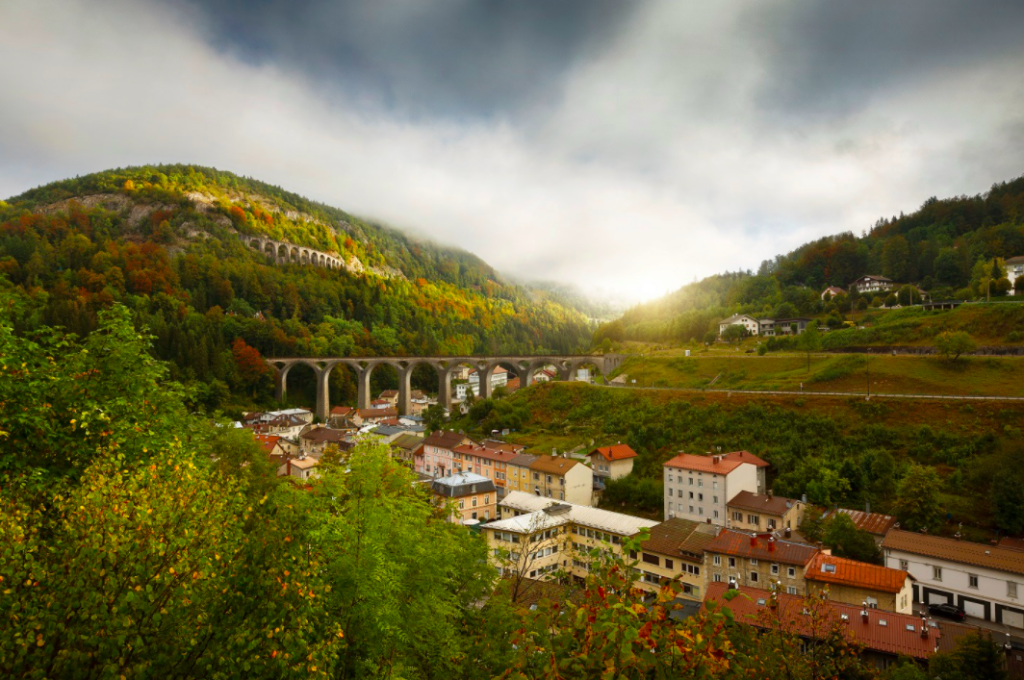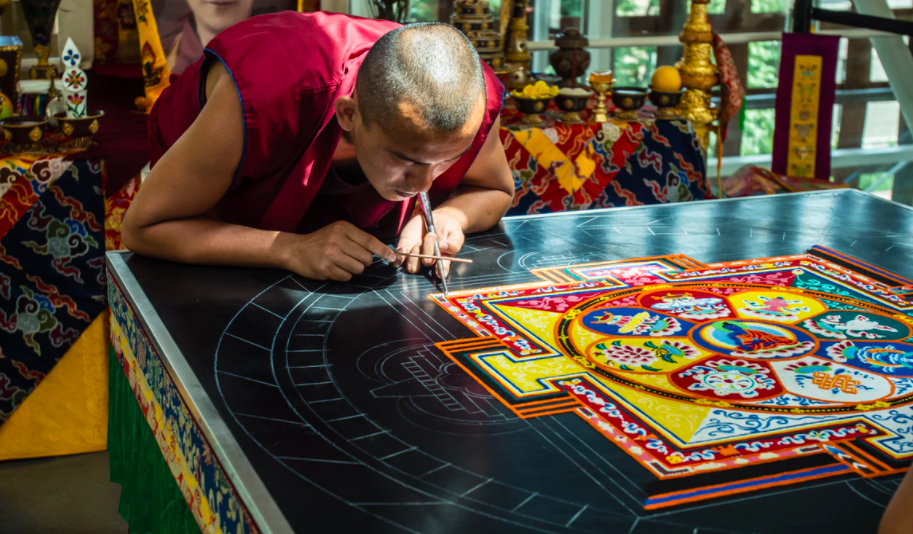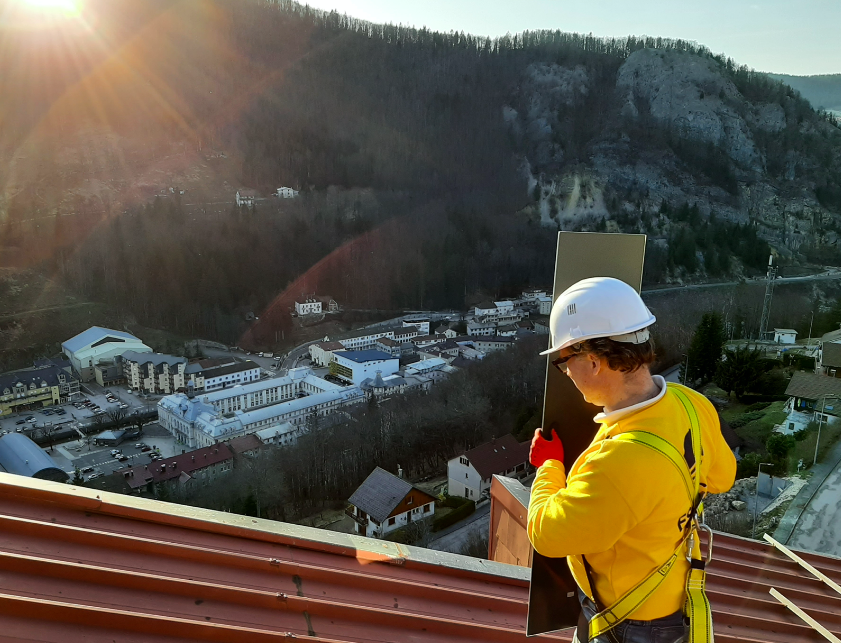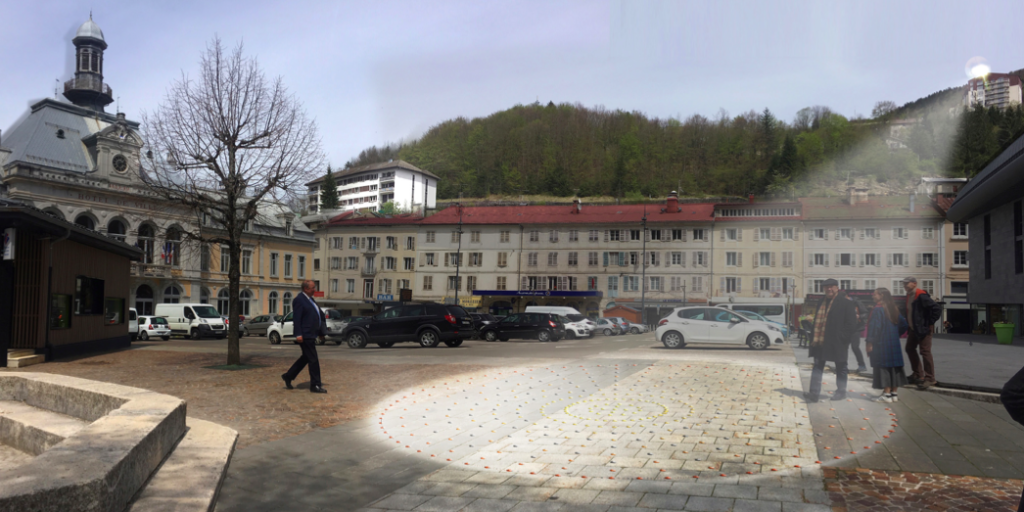The artist Félicie d’Estienne d’Orves called on Espaciel to light Chakpur, a public sculpture designed for the town of Morez, in the Haut Jura.

Project sheet of the work Chakpur :
- Place : City of Morez
- Artist : Félicie d’Estienne d’Orves
- Delegated production : Olivia Sappey, bureau bOssa
- Coordination : Martin Coevoet, Itsok company
- Partners : City of Morez, Arcade, DRAC, Parc Naturel du Haut Jura
- Municipality : Hauts-de-Bienne
- Type of work : Public sculpture
- Context : Mountains of the Haut Jura
- Space to light : Place de la mairie
- Installed Espaciel model : Heliostat

Configuration and solution finding
Chakpur, a sculpture inspired by Tibetan Mandalas
At the request of the Parc Régional Naturel du Haut Jura, the DRAC Bourgone Franche-Comté and the City of Morez, the artist Félicie D’Estienne D’orves has designed Chakpur. This original work is inspired by Tibetan mandalas. Here the mandala is not made of sand but of colored enamel medallions placed on the ground, on the esplanade of the town hall. The mandala is 6m in diameter. When the sun sets, a heliostat located on the heights of the city projects the sun on the work. Espaciel intervenes to conceive and realize this specific device.
The Heliostat follows the movements of the sun in the sky. It consists of a control cabinet, a two axis motor and a reflector. 350 m separate the heliostat from the mandala. The challenge is to transport the sun’s rays to this distance while maintaining the intensity and precision of the solar flux. Such a challenge has never been met before.
There are two comparable hesliostat installations in the mountains. The first one is located in Viganella, Italy. The second is in Rjukan in Norway. However, the delimitation of the solar projection on a precise zone is a specificity of the artistic project in progress in Morez.

Solution implemented
Morez in the spotlight
When Félicie d’Estienne d’Orves contacted Espaciel to participate in the realization of the Chakpur work, I was seduced by the project and impressed by the challenge it represents. The mandala is a fantastic idea to bring people together. It fits naturally on the square of the town hall of Morez which is a place of life and meeting appreciated by the inhabitants.
The solar projection gives the mandala its living and ephemeral dimension. The heliostat is an important aspect of the work. The presence of the sun has a symbolic function. Laurent Petit, the mayor of Morez, gives light an essential role in the city’s development plan. For example, the landscaping and the delimitation of the forests that overhang the city allow the inhabitants to enjoy more sun.
Located at the bottom of the valley, on the banks of the Bienne, the city was a flourishing industrial site until the end of the last century. How can the city be brought back to light and reconnected with its glorious past in the field of enamel, watchmaking and eyewear? The work of Félicie d’Estienne d’Orves is the perfect answer to these aspirations. It materializes the new territorial ambitions of Morez while relying on its history.

Results
Make room for experimentation and discovery!
The implementation of the heliostat of the Chakpur work presents many challenges. Targeting a 6m disc at 350m, from the sun’s rays, has simply never been done. We can’t rely on other comparable experiments. This is a pioneering project, an adventure in itself.
Espaciel is located in Lille, another industrial area in transition. It is from the roofs of Euratechnologies, a former spinning mill, that our small team carries out the tests to study the reflector and the heliostat of the work Chakpur.
Many hypotheses were imagined. One by one, they were all disqualified by the tests and the unusual characteristics of the project. Even the most seductive ideas did not hold their promise at 350m. It was finally Félicie d’Estienne d’Orves who proposed the winning solution. Making a slightly concave reflector to direct the sun’s rays onto the mandala.
At this distance the level of dispersion is such that there is no risk of focusing the sun. Several tests were necessary to understand the optical phenomena involved.

Conclusion
New challenges for the realization of the Chakpur work
The concave surface is a working track validated by the tests. The heliostat project is entering a more advanced phase: its design and implementation. These stages do not lack new difficulties. The precision of the heliostat is a first one. Reconstituting the desired concave surface in a perennial way is another one.
The craftsmen of the region solicited for the ancillary work as well as the co-ownership of the Eperon which will receive the heliostat on its roof and the teams of the partners at the town hall, the DRAC and the Regional Natural Park accompany the project in a regular and benevolent way. It is an asset to move forward and overcome the challenges to come to concretize the work of the artist.
Each actor of the project can feel proud to confront this part of the unknown while being aware of its risks. Many challenges remain to be accomplished so that the sun can have a rendezvous with contemporary art, in Morez, in the Haut-Jura.






